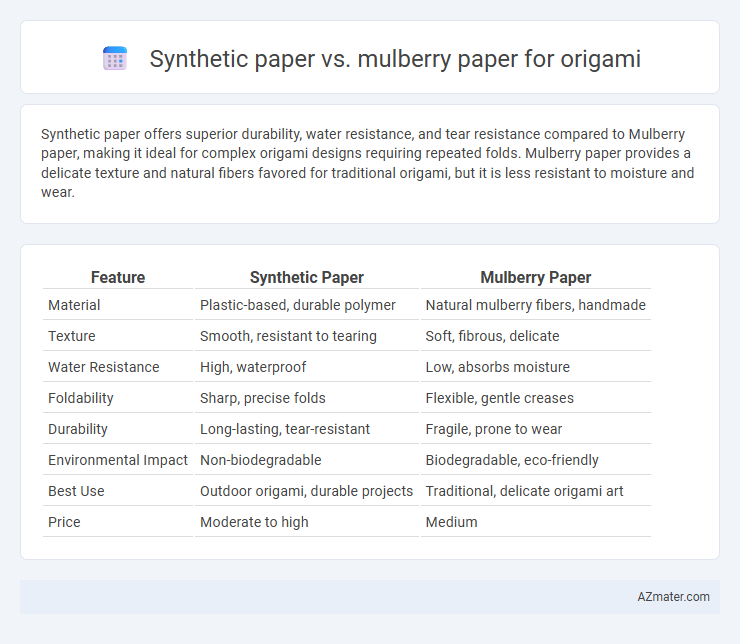Synthetic paper offers superior durability, water resistance, and tear resistance compared to Mulberry paper, making it ideal for complex origami designs requiring repeated folds. Mulberry paper provides a delicate texture and natural fibers favored for traditional origami, but it is less resistant to moisture and wear.
Table of Comparison
| Feature | Synthetic Paper | Mulberry Paper |
|---|---|---|
| Material | Plastic-based, durable polymer | Natural mulberry fibers, handmade |
| Texture | Smooth, resistant to tearing | Soft, fibrous, delicate |
| Water Resistance | High, waterproof | Low, absorbs moisture |
| Foldability | Sharp, precise folds | Flexible, gentle creases |
| Durability | Long-lasting, tear-resistant | Fragile, prone to wear |
| Environmental Impact | Non-biodegradable | Biodegradable, eco-friendly |
| Best Use | Outdoor origami, durable projects | Traditional, delicate origami art |
| Price | Moderate to high | Medium |
Introduction to Origami Paper Types
Synthetic paper offers durability, water resistance, and tear-proof qualities ideal for intricate origami designs requiring precision and longevity, while Mulberry paper, made from natural fibers, provides a lightweight, textured surface favored for traditional folded art and delicate creations. The choice between synthetic and mulberry paper depends on specific origami projects, balancing factors like strength, crease retention, and aesthetic appeal. Incorporating either type enhances the folding experience by catering to different artistic needs and origami techniques.
What is Synthetic Paper?
Synthetic paper is a durable, waterproof material made from plastic resins such as polypropylene or polyethylene, designed to mimic the texture and flexibility of traditional paper while offering enhanced tear resistance. Unlike mulberry paper, which is crafted from natural fibers and known for its lightweight and delicate texture ideal for intricate origami folds, synthetic paper provides superior crease retention and longevity, making it suitable for projects requiring both precision and durability. Its smooth finish and resistance to moisture allow synthetic paper to maintain crisp folds without the risk of damage from handling or environmental factors during complex origami work.
What is Mulberry Paper?
Mulberry paper, also known as kozo paper, is a traditional handmade paper crafted from the fibers of the mulberry tree, renowned for its strength, flexibility, and delicate texture, making it ideal for intricate origami designs. In contrast, synthetic paper is manufactured from plastic-based materials, offering enhanced durability, water resistance, and tear resistance but lacking the natural feel and subtle translucency of mulberry paper. Origami artists often prefer mulberry paper for its organic aesthetic and pliability, while synthetic paper serves practical purposes where moisture and durability are concerns.
Texture and Feel: Synthetic vs Mulberry Paper
Synthetic paper offers a smooth, consistent texture with high durability and water resistance, ideal for precise folds and long-lasting origami projects. Mulberry paper features a fibrous, delicate texture that provides a tactile, organic feel, enhancing the traditional origami experience but requiring careful handling. The choice between synthetic and mulberry paper depends on the desired balance between durability and natural texture in origami creations.
Durability and Strength Comparison
Synthetic paper offers superior durability and tear resistance compared to mulberry paper, making it ideal for complex origami models that require multiple folds and reshaping. Mulberry paper, while appreciated for its natural texture and flexibility, is more prone to ripping and wear under repeated folding stress. The synthetic variant maintains structural integrity over time, providing a longer-lasting finished piece in origami projects.
Folding Precision and Crease Quality
Synthetic paper offers superior folding precision due to its consistent texture and resistance to tearing, making it ideal for intricate origami designs. Mulberry paper, while more delicate, provides excellent crease quality with soft, natural fibers that hold folds gently without harsh lines. Artists often choose synthetic paper for complex, sharp folds and mulberry paper for projects requiring a more organic, textured finish.
Color Vibrancy and Printability
Synthetic paper offers superior color vibrancy and printability for origami, thanks to its smooth, non-porous surface that allows inks to sit on top without bleeding or fading. In contrast, mulberry paper, while prized for its textured, natural fiber appearance, tends to absorb inks deeply, resulting in more muted colors and less precise print details. Artists seeking bold, vivid designs or detailed prints typically prefer synthetic paper over mulberry paper for origami projects.
Environmental Impact and Sustainability
Synthetic paper, often made from petroleum-based polymers, poses environmental challenges due to its non-biodegradable nature and reliance on fossil fuels, leading to long-term waste and pollution concerns. Mulberry paper, derived from renewable plant fibers of the Morus alba tree, is biodegradable and sustainably harvested, supporting eco-friendly origami practices. Choosing mulberry paper significantly reduces environmental footprint by promoting renewable resource use and minimizing synthetic waste in origami art.
Suitability for Complex Origami Models
Synthetic paper offers superior durability and tear resistance, making it highly suitable for intricate and complex origami models that require multiple folds and precise creases. Mulberry paper, while lightweight and flexible, tends to be more delicate and prone to tearing, limiting its effectiveness for detailed or multi-layered origami creations. The dimensional stability and smooth surface of synthetic paper provide consistent fold retention and clean lines essential for advanced origami techniques.
Choosing the Right Paper for Your Origami Projects
Synthetic paper offers durability, water resistance, and smooth texture ideal for precise folds in origami, while Mulberry paper provides a natural fiber composition, softness, and translucency that enhance traditional and decorative designs. Selecting the right paper depends on project requirements: use synthetic paper for intricate, long-lasting models and Mulberry paper to achieve organic aesthetics and delicate detailing. Understanding the material properties and desired outcome ensures optimal folding experience and final artwork quality.

Infographic: Synthetic paper vs Mulberry paper for Origami
 azmater.com
azmater.com